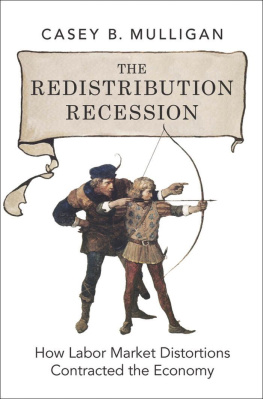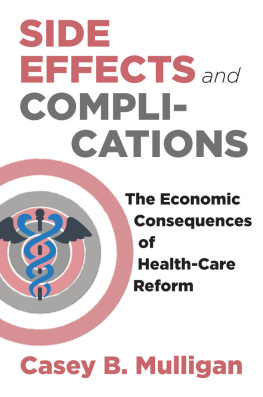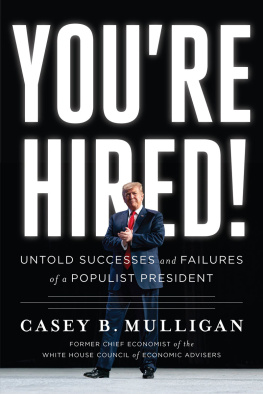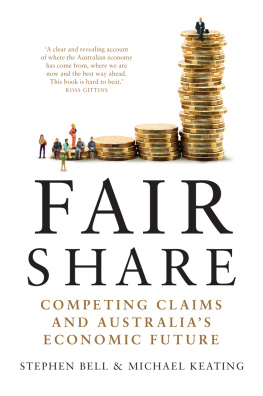The Redistribution Recession
The Redistribution Recession
How Labor Market Distortions Contracted the Economy
CASEY B. MULLIGAN


Oxford University Press is a department of the University of Oxford. It furthers the Universitys objective of excellence in research, scholarship, and education by publishing worldwide
Oxford New York
Auckland Cape Town Dar es Salaam Hong Kong Karachi
Kuala Lumpur Madrid Melbourne Mexico City Nairobi
New Delhi Shanghai Taipei Toronto
With offices in
Argentina Austria Brazil Chile Czech Republic France Greece
Guatemala Hungary Italy Japan Poland Portugal Singapore
South Korea Switzerland Thailand Turkey Ukraine Vietnam
Oxford is a registered trade mark of Oxford University Press in the Uk and certain other countries
Published in the United States of America by
Oxford University Press
198 Madison Avenue, New York, NY 10016
Oxford University Press 2012
All rights reserved. No part of this publication may be reproduced, stored in a retrieval system, or transmitted, in any form or by any means, without the prior permission in writing of Oxford University Press, or as expressly permitted by law, by license, or under terms agreed with the appropriate reproduction rights organization. Inquiries concerning reproduction outside the scope of the above should be sent to the Rights Department, Oxford University Press, at the address above.
You must not circulate this work in any other form and you must impose this same condition on any acquirer.
Library of Congress Cataloging-in-Publication Data
Mulligan, Casey B.
The redistribution recession: how labor market distortions contracted the economy / Casey B. Mulligan.
p. cm.
Includes bibliographical references and index.
ISBN 978-0-19-994221-3 (cloth: alk. paper) 1. Labor marketUnited States21st century. 2. RecessionsUnited StatesHistory21st century. 3. Income distributionUnited StatesHistory21st century. I. Title.
HD5724.M83 2012
331.120973090511dc23 2012030181
1 3 5 7 9 8 6 4 2
Printed in the United States of America on acid-free paper
To the Mulligan kids: Jack, Marc, John Casey, and Ella!
Contents
Preface
THROUGHOUT MY CAREER as an economist, I have been interested in the mutual feedback between economic activity and public policy. In studying those issues, I began to appreciate not only that taxes matter but also that public finance concepts such as tax distortions help in understanding private sector activity, even in those cases where market outcomes are less than fully efficient for reasons that have nothing to do with public policy. Like millions of other people, I turned my attention to the monthly U.S. economic data releases after Lehman Brothers failed in September 2008, except that in my mind labor market distortions were the way to organize that news. The effort yielded some surprising and unconventional conclusions, and some of the connections with taxation turned out to be as much literal as conceptual.
My essential results require only a few relatively simple economic concepts, and they point to the potential for important contributions to recession economics from fields as diverse as poverty analysis, law, political science, labor, and macroeconomics. Hoping to facilitate entry by these varied experts, I decided to rework my analysis of recent labor market eventsmuch of it previously unpublishedinto a book written for social scientists generally interested in why employment fell so much in 2008 and 2009 and has so far failed to recover. The first four chapters introduce economic jargon sparingly, with clear definitions, and leave technical notes to endnotes and appendices, and yet they are able to both identify and quantify (what I think are) the main economic forces affecting the labor market. The second half of the book pushes the argument further and offers tests of key assumptions, but in a style that is more familiar to economics graduate students than to noneconomists. All of the chapters contain the details necessary for a professional economist to replicate my results.
I thank Julia and the rest of my family, Tsega Beyene, and Mekdes Yohannes for helping me dedicate the time needed to write this book. Fernando Alvarez, Gary Becker, John Covell, Bob Dalrymple, Steve Davis, Bill Dougan, Aaron Edlin, Gauti Eggertsson, Christian Ferrada, Joe Jackson, Kyle Herkenhoff, Matt Kahn, Emir Kamenica, Michael Kirker, Elizabeth Lower-Basch, Bruce Meyer, Jeff Miron, Robert Moffitt, Tom Mulligan, Kevin Murphy, Derek Neal, David Neumark, Marcus Nunes, Lee Ohanian, Nicola Pavoni, Tomas Philipson, Yona Rubinstein, Jesse Shapiro, Rob Shimer, Andrei Shleifer, Curtis Simon, Cheryl Sturm, Luke Threinen, Kevin Tsui, Glen Weyl, Paul Willen, more than a dozen anonymous referees, and graduate students, undergraduate students, and seminar participants at the University of Chicago, the Congressional Budget Office, Brown, Clemson, the FDIC, the Federal Reserve Board, Harvard, MIT, the New York Federal Reserve, Tel Aviv University, UC Irvine, UCLA, Wheaton College, Wisconsin, and the World Bank improved this book with their comments on research papers that were the basis for book chapters. Kevin McKenna, Josh Mills, and Catherine Rampell also helped with their comments and suggestions on my posts at economix.blogs.nytimes.com about related topics. I also appreciate the assistance of Sophie Wang, Eric Anderson, Ada Barbosa, and Getfridays Vishwas; computing support from the National Bureau of Economic Research; the financial support of the George J. Stigler Center for the Study of the Economy and the State; and support from the University of Chicagos Division of Social Sciences during a part-year leave of absence that allowed this book to get started.
Chicago
March 2012
The Redistribution Recession
1
Introduction
I can remember sitting in the Roosevelt Room with Hank Paulson and Ben Bernanke and others, and they said to me that if we dont act boldly, Mr. President, we could be in a depression greater than the Great Depression.
PRESIDENT GEORGE W. BUSH (December 1, 2008, ABC News interview)
AS THE PRESIDENT was warned by his advisers, market economies were dramatically cutting back their labor usage. Between the end of 2007 and the end of 2009, the fraction of Americans with jobs fell 7 percent, and hours worked per capita fell 10 percent. Would the U.S. recession have been deeper if the federal government had not intervened in financial markets and had not enhanced its safety nets for the unemployed and the poor? Or were the labor market declines amplified and prolonged by federal government actions?
The answers to these questions depend on the causes of labor market change. Labor economists prior to the recession often explained market outcomes in terms of fundamentals in the labor market itself: worker productivity, the willingness of people to work, labor income taxes, and labor market regulations. But the large labor collapse of 200809, and the capital market crashes occurring at about the same time, created and renewed interest in impulses from outside the labor market such as a drop in investment, financial deleveraging, a liquidity trap, and a lack of consumer confidence.
Although the less proximate impulses have been mentioned for years, less is known about their quantitative importance or exactly how to trace their links to the labor market through a chain of microeconomic reasoning. If we assume for the moment that labor market fundamentals still influence labor market outcomes, but in this recession they were perhaps joined by less proximate impulses, it is helpful to adjust actual labor market outcomes for the fundamentals. This book estimates what would have happened to labor usage and other major economic variables if productivity, the willingness of people to work, labor income tax rates, and labor market regulations had remained constant. The decline in labor usage that remains can be interpreted as the combined influence of remaining impulses such as a lack of consumer confidence, the drop in investment, etc., to the extent that they have an influence separate from the fundamentals.
Next page











